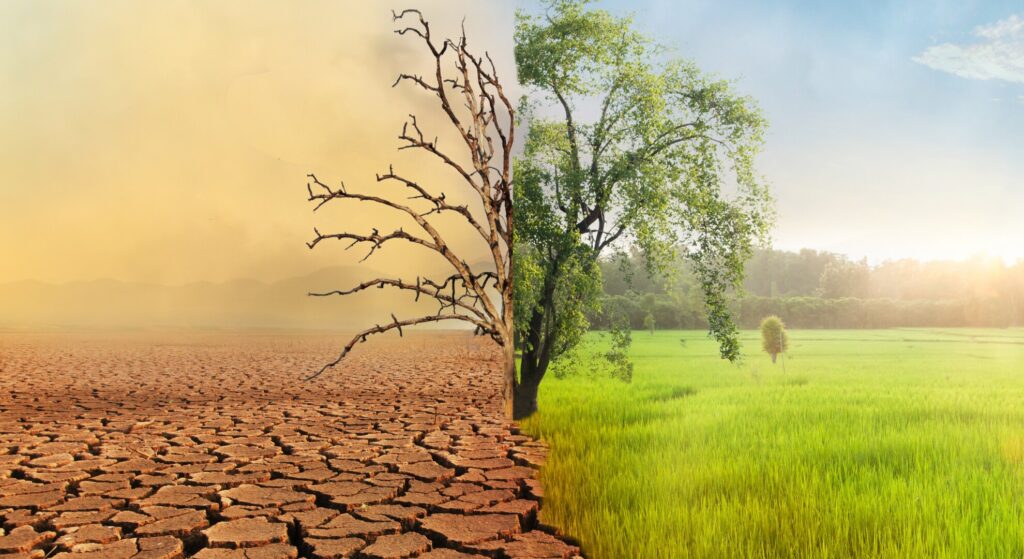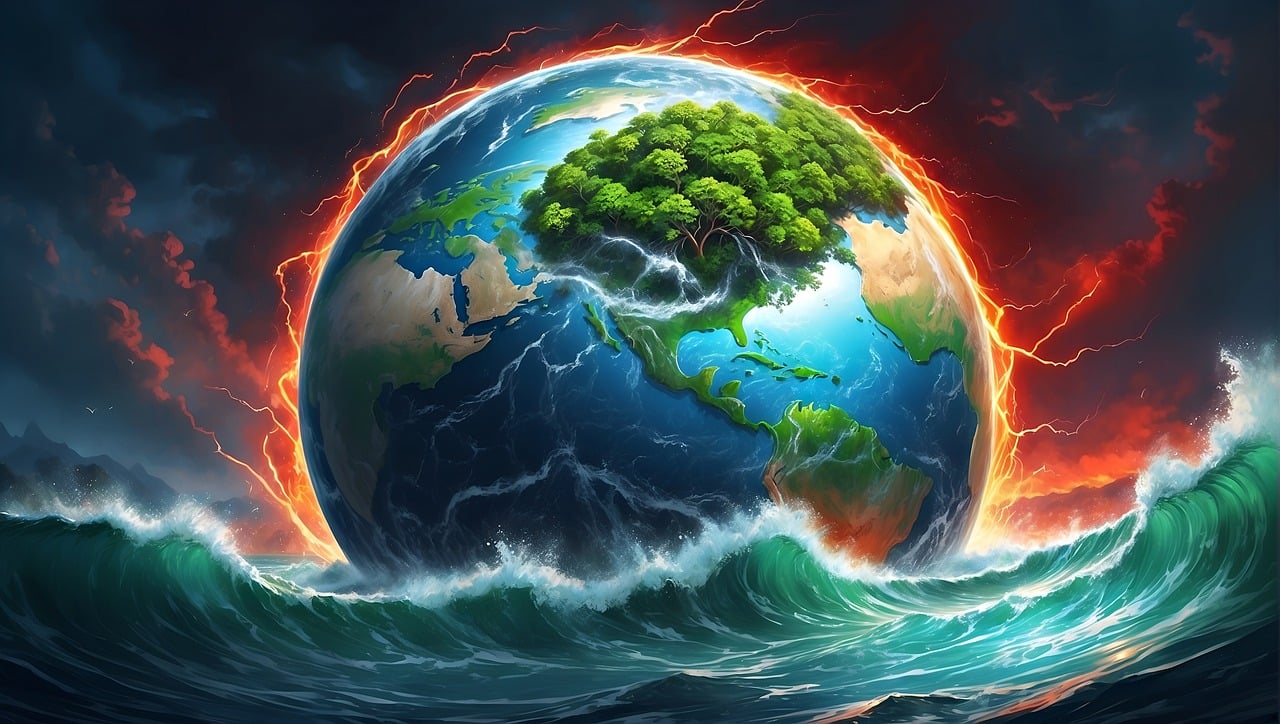Table of Content
Climate change is one of the biggest problems we face today. As the Earth gets warmer, we’re seeing more severe weather, rising sea levels, and serious impacts on nature and our health. These challenges make it clear that we need to find solutions to slow down and adapt to climate change. In this Blog, we’ll look at some of the most effective ways to create a sustainable future.
What Causes Climate Change?

To address climate change, we first need to understand what causes it. The main cause is the buildup of greenhouse gases in the atmosphere. These gases, like carbon dioxide (CO2), methane, and nitrous oxide, trap heat from the sun and make the planet warmer.
1. Greenhouse Gas Emissions
The biggest source of these gases is the burning of fossil fuels, such as coal, oil, and natural gas, for energy. When we burn these fuels for electricity, transportation, or heating, large amounts of CO2 are released into the air. This is a major contributor to global warming. Besides CO2, other gases like methane, which comes from farming and waste, and nitrous oxide, released by some industries and fertilizers, also add to the problem.
2. Deforestation and Land Changes
Cutting down forests, or deforestation, is another big contributor to climate change. Trees absorb CO2 from the air, storing it in their wood and soil. When forests are cleared for farming, logging, or building, this stored carbon is released back into the air, making global warming worse. Plus, fewer trees mean less CO2 is absorbed from the atmosphere, speeding up climate change.
3. Harmful Farming Practices
Agriculture, or farming, is another major source of greenhouse gases. Practices like using too much synthetic fertilizer, inefficient watering, and raising large numbers of livestock release methane and nitrous oxide. Also, converting natural areas into farmland often involves cutting down trees, which further increases emissions.
4. Industrial Activities
Certain industries, like making cement, steel, and chemicals, also release large amounts of greenhouse gases. These processes not only use a lot of energy, usually from fossil fuels, but they also release CO2 and other gases as byproducts.
How to Reduce Greenhouse Gas Emissions

To slow down climate change, we need to reduce the amount of greenhouse gases we release. Here are some of the most effective ways to do that:
1. Switching to Renewable Energy
One of the best ways to cut greenhouse gas emissions is to move away from fossil fuels and start using renewable energy sources instead. Renewable energy, like solar, wind, and hydropower, doesn’t produce CO2 when generating electricity. By investing in these clean energy sources, we can reduce our reliance on fossil fuels and lower our emissions.
For example, solar energy captures sunlight using panels and turns it into electricity. Wind energy uses turbines to harness the power of the wind, and hydropower generates electricity by using the flow of water to turn turbines. These technologies have become more advanced, cheaper, and more accessible in recent years, making them a practical option for reducing emissions.
2. Improving Energy Efficiency
Another important way to reduce greenhouse gas emissions is by making our use of energy more efficient. Energy efficiency means using less energy to do the same job, like heating a home, driving a car, or running a factory.
In buildings, we can improve energy efficiency by using better insulation, energy-saving windows, and smart thermostats. In transportation, driving fuel-efficient vehicles, using public transport, and promoting electric cars can reduce emissions. In industry, using more efficient machinery and processes can lead to big energy savings.
3. Using Carbon Pricing and Emissions Trading
Carbon pricing and emissions trading are financial tools that can help reduce greenhouse gas emissions. Carbon pricing puts a cost on emitting CO2, making it more expensive to pollute. This encourages businesses and individuals to find ways to reduce their carbon emissions.
Emissions trading, also known as cap-and-trade, sets a limit on the total amount of greenhouse gases that certain industries can emit. Companies are given permits to emit a certain amount of CO2. If they emit less than their limit, they can sell their extra permits to other companies. This system encourages companies to cut their emissions and adopt cleaner practices.
4. Promoting Sustainable Farming and Land Use
Sustainable farming and land use can also help reduce greenhouse gas emissions. This includes practices like planting trees (reforestation), mixing trees with crops (agroforestry), and using farming methods that reduce the need for synthetic fertilizers and cut down on methane emissions from livestock.
Reforestation helps by absorbing CO2 from the air as new trees grow. Agroforestry integrates trees into farmland, which can store carbon and improve soil health. Sustainable farming practices, like rotating crops, avoiding plowing, and using natural fertilizers, can reduce the need for chemicals and lower emissions from agriculture.
Adapting to Climate Change: Building Resilience
While cutting emissions is important, we also need to prepare for the changes that are already happening due to climate change. Adaptation strategies help us build resilience to these changes and get ready for future challenges. Here are some key ways to adapt:
1. Building Climate-Resilient Infrastructure
To protect communities from the impacts of climate change, it’s important to invest in infrastructure that can withstand extreme weather. This includes things like flood defenses, buildings designed to resist storms, and smart urban planning.
Flood defenses, such as levees, sea walls, and drainage systems, help protect areas from rising sea levels and heavy rains. Buildings that are designed to resist strong winds, heavy rain, and other extreme weather can keep people safe during storms. Smart urban planning, which includes green spaces, permeable surfaces, and natural water management, can help reduce the risk of flooding and heat in cities.
2. Securing Food and Water Supplies
Climate change threatens our food and water supplies, especially in areas that already struggle with drought, extreme weather, and changes in rainfall patterns. To ensure we have enough food and water in the future, we need to develop strategies that make our supplies more secure.
One way to do this is by developing crops that can survive in dry conditions and don’t need much water. Improving irrigation systems, like using drip irrigation or collecting rainwater, can help farmers use water more efficiently. Protecting and restoring water sources, such as rivers, lakes, and underground reserves, is also crucial for keeping our water supply steady.
3. Strengthening Health Systems
Climate change affects our health in many ways, from spreading diseases to causing heat-related illnesses and mental health problems. Strengthening our health systems is key to protecting people from these impacts.
This includes improving systems that track and respond to disease outbreaks, especially those linked to climate change, like malaria, dengue fever, and waterborne diseases. Ensuring that everyone has access to basic healthcare, including vaccinations, medical care, and mental health support, is also important. Public health campaigns that teach people about the health risks of climate change and how to prevent them can help communities stay healthy.
The Importance of Global Cooperation and Funding
Tackling climate change is a global challenge that requires everyone to work together. No single country can solve this problem alone because climate change affects everyone. International cooperation and funding are crucial for supporting efforts to reduce emissions and adapt to climate change, especially in poorer countries that are most vulnerable.
1. Building Global Partnerships
Global partnerships are essential for sharing knowledge, resources, and technologies that can help countries move toward a low-carbon, climate-resilient future. International organizations like the United Nations, the World Bank, and the International Monetary Fund play a big role in creating these partnerships and supporting countries that need help.
2. Raising Financial Support
Raising enough money is critical for funding climate action. This includes money from governments, private businesses, and international aid. Richer countries have a responsibility to support poorer countries by providing funds to help them reduce emissions, adapt to climate change, and build resilience.
3. Sharing Sustainable Technologies
Sharing sustainable technologies from developed to developing countries is key to enabling climate action around the world. This includes technologies for renewable energy, energy efficiency, sustainable farming, and climate-resilient infrastructure. By sharing these technologies, richer countries can help poorer nations leapfrog to a more sustainable future, avoiding the mistakes of the past.
Conclusion
Climate change is one of the biggest challenges of our time, but it’s not unbeatable. By understanding the causes of climate change and taking effective steps to reduce emissions and adapt to changes, we can work toward a more sustainable future. It’s crucial that we all work together—locally and globally—to tackle this problem. The time to act is now, and together, we can create a better world for future generations.
FAQs
1. What are the main effects of climate change on daily life?
Climate change causes extreme weather events, rising sea levels, and changes in water availability, which impact homes, health, and daily routines.
2. How can individuals help fight climate change?
Individuals can reduce energy use, use public transport, recycle, support renewable energy, and eat a plant-based diet to lower their carbon footprint.
3. Why is climate change a global concern?
Climate change affects everyone. It causes global shifts in weather, disrupts ecosystems, and threatens food and water supplies worldwide, requiring global cooperation.

Leave a Reply